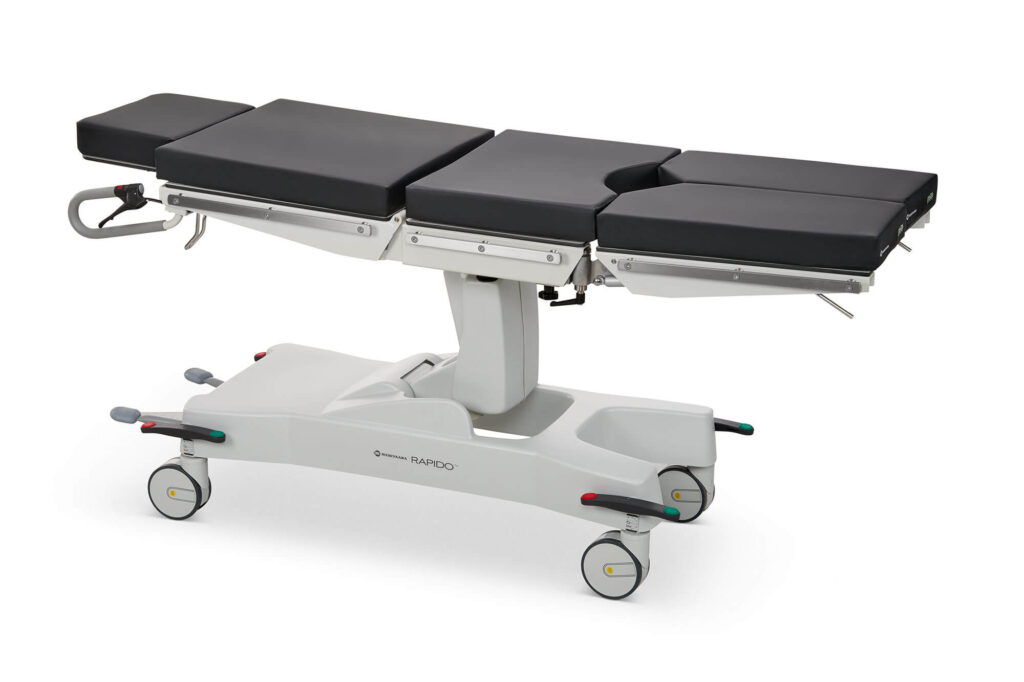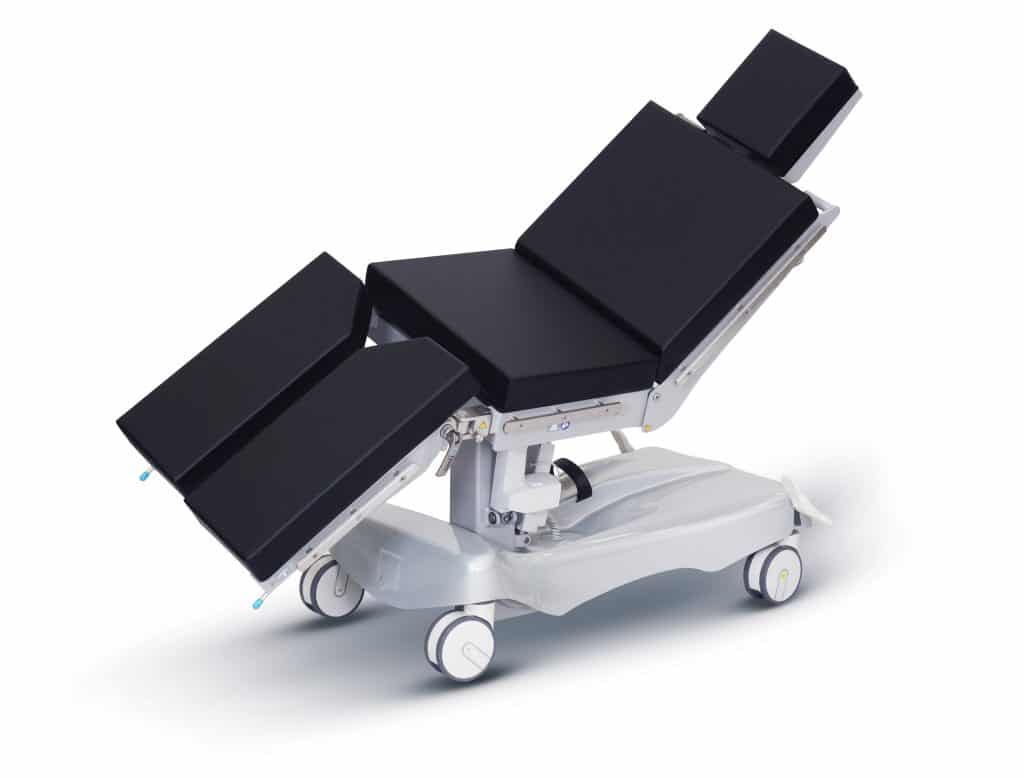Merivaara Rapido Hospital Trolley vs OpFlex Day Surgery Trolley – An Honest Comparison
There are several stretchers on the market designed for use in day surgery, and in this article, we compare the Rapido Hospital Trolley with the OpFlex Day Surgery Stretcher.
While these two products may look similar, they both have different features and positives and drawbacks. So, in this article, we attempt to provide an unbiased comparison of these products – and then leave you to make up your mind.
What is the Merivaara Rapido?

Merivaara, a Finnish company now owned by Lojer, is another professional and longstanding company that has been trading since 1901. Again a smaller player in the UK, the Rapido is a good quality but more basic trolley when considered for day surgery.
Pros of the Rapido
- Lightweight
- Headrest Adjustment Range
- Footrest Adjustment Range
- Best Trendelenburg Angle on the market
- Warranty
Lightweight
The Rapido weighs only 125kgs – much lighter than the OpFlex which weighs around 160kgs.
Headrest Adjustment Range
The Rapido has -40 to+25 degrees of headrest adjustment, which is less adjustment than the OpFlex.
Footrest Adjustment Range
The angle range is -90 to +4 degrees – so no adjustment elevation but they do drop down out of the way.
Best Trendelenburg Angle on the market
-25 to +18 degrees of adjustment mean that the Rapido has the biggest Trendelenburg range of all comparable products. This feature will be of most benefit in laparoscopy, and in particular, cholecystectomy.
Warranty
There’s a 2-year warranty as standard – and to be honest, you wouldn’t expect any less.
Cons of the Rapido
- Hydraulic operation
- Hook and Loop
- Limited headrest compatibility
- Price
Hydraulic operation
Adjusting the height of a trolley hydraulically involves repeated pumping of a foot pedal which can cause a jerky ascent for the patient. Sometimes there’s a technical or practical reason for this (for example in a field theatre or where there is limited 240V power) – however, it’s hard to fathom why a day surgery table would not have electrical height adjustment.
Velcro-style Hook and Loop
Hook and Loop is a real opinion-divider – whilst it can often be easily changed, it’s fair to say that IPC staff hate it due to its unique ability to attract dirt and fluff. With other tables and stretchers, you can opt for alternative methods of holding the mattress pieces in place – but with the Rapido, you’re stuck with it (quite literally).
Limited headrest compatibility
Some of the headrests are unique to the Rapido and it appears as if there’s not much ability to use headrests from other manufacturers.
Price
The Rapido is not more expensive; in fact, it’s priced on a par with other products – however, there are no electric functions at all so it might be considered that you’re getting less for the same money.
What about the OpFlex?

The OpFlex is manufactured by a well-known company called FAMED, based in Poland. The model number is the SU-14. Whilst not as well known in the UK, this company is over 75 years old and their attention to quality is outstanding. The attention to detail can be noticed in areas such as the universal rails which are deburred by hand to make sure there are no sharp edges.
Pros of the OpFlex
- Great range of accessories for different procedures
- Kyra Stirrups – great for gynaecology/lithotomy
- Adjustability of Backrest
- Ability to drop Leg Section/s to -90deg
- Leg Abduction
- Best Lateral Side tilt angle
- X-Ray Translucency
- Trendelenburg Angle
- Ability to use headrests & positioning accessories from other manufacturers
- Warranty
Great range of accessories for different surgical procedures
It goes without saying that everyday surgery table needs a good range of quality surgical accessories. There are over 60 standard accessories to go with the OpFlex.
Kyra Stirrups – great for gynaecology/lithotomy
As mentioned above, these stirrups are a real game-changer. Their abduction range is the same as the Lift-Assist stirrups however the lithotomy angle range is -55 to +85 (Lift-Assist ones cannot go below -35). With no Velcro the Kyra stirrups are better for IPC and the one-handed operation is simply quicker and easier to use.
Adjustability of Backrest
The OpFlex backrest adjusts from -40 to +85 degrees. Compare this to the Rapido (-4 to +70 degrees) to fully understand just how adjustable the OpFlex backrest is.
Ability to drop Leg Section/s to -90deg
The reason this is such a positive feature of the OpFlex is because it enables the surgeon to drop the leg section right down and out of the way but there is NO need to remove it when adding stirrups etc. This saves time and heavy lifting, particularly noticeable when doing a gynae list.
Leg Abduction
It’s also worth noting that the divided legs pivot sideways to allow for leg abduction – a very helpful feature for varicose vein procedures, removing the need to purchase any dedicated accessories to achieve this functionality.
Best Lateral Side tilt angle
The OpFlex tilts to 20 degrees on both sides and this is a powered feature. The Rapido can tilt to 15 degrees in both directions and is manual.
Trendelenburg Angle
There are 20 degrees of Trendelenburg tilt on the OpFlex compared to 25 degrees on the Rapido. In some situations, this may make a difference with laparoscopic procedures such as cholecystectomy (gall bladder removal).
X-Ray Translucency
Although there’s no longitudinal shift, the lifting column is mounted at the hip area, meaning the torso is unobstructed for imaging. The backrest is fully translucent as there’s no motor obstructing the X-Ray field.
Ability to use headrests & positioning accessories from other manufacturers
Thanks to the adapters available, clinicians can use different types of headrests and head positioning accessories from the Famed portfolio and also headrest systems from third parties such as PMI (DORO) or Mayfield.
Warranty
The standard warranty is 2 years and there are longer warranties available.
Cons of the OpFlex
- No longitudinal shift
- No dedicated CPR button
- Gas-assisted backrest
- Less familiarity
No longitudinal shift
As we stated above, this feature just isn’t available. There are certain procedures for which this feature is really beneficial.
No dedicated CPR button
For CPR, lowering the backrest with the lever takes only a few seconds. Although this is pretty quick, it might be that clinicians would naturally look for a dedicated CPR button which may cause an unnecessary delay.
Gas-assisted backrest (for now)
An electrical backrest would often offer a smoother angle adjustment – however, the OpFlex is gas-assisted so may be a little less smooth. It’s worth noting that an electrical backrest option is in development by FAMED at the time of writing this article.
Less familiarity
As the OpFlex is still relatively new to the UK, not many clinicians will have had experience in using this product. It is therefore paramount that staff training is considered and planned for at the initial planning stages.
Summary
Hopefully, this article has served to explain some of the key differences between the Rapido and OpFlex stretchers. Ultimately the best judge for what to choose is you though, and there’s no better way to form a judgement than to trial the equipment in your hospital.
Felgains are exclusive suppliers of the OpFlex Day Surgery Trolley, and we offer the option for you to trial in your hospital – click here to find out more.
Related articles
What is patient flow? Statistics, challenges, and consequences of poor patient flow in the NHS
How does the Felgains MultiFlow Low-Height Stretcher improve efficiency in emergency departments?
Felgains MultiFlow Low Stretcher vs Howard Wright M9 Low Stretcher; How do they compare?
Get in touch
Got a question or want to send us a message? Let’s talk.